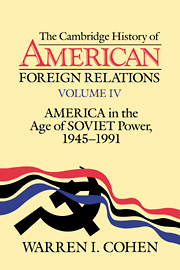Book contents
- Frontmatter
- Prelude
- 1 At war’s end: visions of a new world order
- 2 Origins of the Cold War
- 3 The Korean War and its consequences
- 4 New leaders and new arenas in the Cold War
- 5 Crisis resolution
- 6 America’s longest war
- 7 The rise and fall of Détente
- 8 In God’s country
- Conclusion: America and the world, 1945–1991
- Bibliographic essay
- Index
- THE CAMBRIDGE HISTORY OF AMERICAN FOREIGN RELATIONS
- References
Conclusion: America and the world, 1945–1991
Published online by Cambridge University Press: 28 March 2008
- Frontmatter
- Prelude
- 1 At war’s end: visions of a new world order
- 2 Origins of the Cold War
- 3 The Korean War and its consequences
- 4 New leaders and new arenas in the Cold War
- 5 Crisis resolution
- 6 America’s longest war
- 7 The rise and fall of Détente
- 8 In God’s country
- Conclusion: America and the world, 1945–1991
- Bibliographic essay
- Index
- THE CAMBRIDGE HISTORY OF AMERICAN FOREIGN RELATIONS
- References
Summary
The era herein reviewed began in the closing months of World War II and ended with the disappearance of the Soviet Union. The central thread in the tapestry of the international politics of the time was the Soviet-American confrontation. In 1945, the Soviet Union and the United States, allied in the war against the Axis powers, crushed their enemies and emerged from the war triumphant, each with only the other remaining as a credible adversary. The next forty-five years constituted what John Lewis Gaddis has called the “Long Peace,” as the two great empires competed without direct conflict between them. And then the Soviet empire collapsed and was gone.
The period was also striking because of the disintegration of all of the pre–World War II colonial empires, and the appearance of scores of newly independent states in Africa, Asia, and Latin America. As each of these new nations struggled to define itself, to search for some modicum of wealth and power, it contributed another ripple to the tides of world affairs, sometimes barely perceptible, often so evident as to force one or both of the great powers to change course. There was too much turmoil in the world for any country, even one as powerful as the United States, to exercise hegemony. And along the way the locus of power shifted, as Chinese military strength developed, and as Japan, South Korea, and the ASEAN states demonstrated their economic vitality.
- Type
- Chapter
- Information
- The Cambridge History of American Foreign Relations , pp. 246 - 261Publisher: Cambridge University PressPrint publication year: 1993



